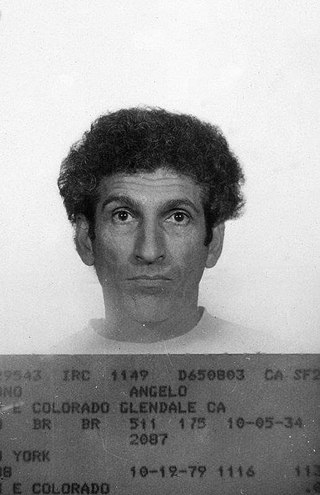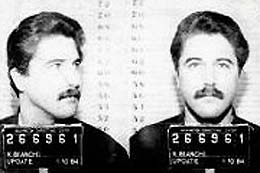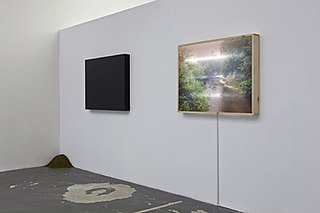Related Research Articles
The Hillside Strangler, later the Hillside Stranglers, is the media epithet for one, later discovered to be two, American serial killers who terrorized Los Angeles, California, between October 1977 and February 1978, with the nicknames originating from the fact that many of the victims' bodies were discovered in the hills surrounding the city.

Angelo Anthony Buono Jr. was an American serial killer, kidnapper and rapist who, together with his adopted cousin Kenneth Bianchi, were known as the Hillside Stranglers. Buono and Bianchi were convicted of killing ten young women in Los Angeles, California, between October 1977 and February 1978.

Kenneth Alessio Bianchi is an American serial killer, kidnapper, and rapist. He is known for the Hillside Strangler murders committed with his cousin Angelo Buono Jr. in Los Angeles, California, as well as for murdering two more women in Washington by himself. Bianchi is currently serving a sentence of life imprisonment in Washington State Penitentiary for these crimes. Bianchi was also at one time a suspect in the Alphabet murders, three unsolved murders in his home city of Rochester, New York, from 1971 to 1973.
The Woman's Building was a non-profit arts and education center located in Los Angeles, California. The Woman's Building focused on feminist art and served as a venue for the women's movement and was spearheaded by artist Judy Chicago, graphic designer Sheila Levrant de Bretteville and art historian Arlene Raven. The center was open from 1973 until 1991. During its existence, the Los Angeles Times called the Woman's Building a "feminist mecca."
Suzanne Lacy is an American artist, educator, writer, and professor at the USC Roski School of Art and Design. She has worked in a variety of media, including installation, video, performance, public art, photography, and art books, in which she focuses on "social themes and urban issues." She served in the education cabinet of Jerry Brown, then mayor of Oakland, California, and as arts commissioner for the city. She designed multiple educational programs beginning with her role as performance faculty at the Feminist Studio Workshop at the Woman's Building in Los Angeles.
Cheri Gaulke is a visual artist and filmmaker most known for her role in the Feminist Art Movement in southern California in the 1970s and her work on gay and lesbian families.
Faith Wilding is a Paraguayan American multidisciplinary artist - which includes but is not limited to: watercolor, performance art, writing, crocheting, knitting, weaving, and digital art. She is also an author, educator, and activist widely known for her contribution to the progressive development of feminist art. She also fights for ecofeminism, genetics, cyberfeminism, and reproductive rights. Wilding is Professor Emerita of performance art at the School of the Art Institute of Chicago.

LA Freewaves, also known as Freewaves, is a Los Angeles–based nonprofit organization that exhibits new, uncensored, independent media, and produces free public art projects to engage artists and audiences on current social issues. Anne Bray, with representatives of other communities, founded LA Freewaves in 1989 and has worked to administer the non-profit since it was launched as an exhibition of multicultural video art at the American Film Institute's National Video Festival. Bray serves as director of the organization and has been working in the field of media arts since the mid-1970s as an artist and teacher.

The Getty Research Institute (GRI), located at the Getty Center in Los Angeles, California, is "dedicated to furthering knowledge and advancing understanding of the visual arts".

The feminist art movement in the United States began in the early 1970s and sought to promote the study, creation, understanding and promotion of women's art. First-generation feminist artists include Judy Chicago, Miriam Schapiro, Suzanne Lacy, Judith Bernstein, Sheila de Bretteville, Mary Beth Edelson, Carolee Schneeman, Rachel Rosenthal, and many other women. They were part of the Feminist art movement in the United States in the early 1970s to develop feminist writing and art. The movement spread quickly through museum protests in both New York and Los Angeles, via an early network called W.E.B. that disseminated news of feminist art activities from 1971 to 1973 in a nationally circulated newsletter, and at conferences such as the West Coast Women's Artists Conference held at California Institute of the Arts and the Conference of Women in the Visual Arts, at the Corcoran School of Art in Washington, D.C..
Nancy Angelo is an organizational psychologist and formerly a performance and video artist who took part in the feminist art movement in Los Angeles. As an artist, she is best known for co-founding the collaborative performance art group The Feminist Art Workers in 1976 with Candace Compton, Cheri Gaulke, and Laurel Klick.
The feminist art movement refers to the efforts and accomplishments of feminists internationally to produce art that reflects women's lives and experiences, as well as to change the foundation for the production and perception of contemporary art. It also seeks to bring more visibility to women within art history and art practice. The movement challenges the traditional hierarchy of arts over crafts, which views hard sculpture and painting as superior to the narrowly perceived 'women's work' of arts and crafts such as weaving, sewing, quilting and ceramics. Women artists have overturned the traditional view by, for example, using unconventional materials in soft sculptures, new techniques such as stuffing, hanging and draping, and for new purposes such as telling stories of their own life experiences. The objectives of the feminist art movement are thus to deconstruct the traditional hierarchies, represent women more fairly and to give more meaning to art. It helps construct a role for those who wish to challenge the mainstream narrative of the art world. Corresponding with general developments within feminism, and often including such self-organizing tactics as the consciousness-raising group, the movement began in the 1960s and flourished throughout the 1970s as an outgrowth of the so-called second wave of feminism. It has been called "the most influential international movement of any during the postwar period."

Andrea Bowers, is an American artist working in a variety of media including video, drawing, and installation. Her work has been exhibited around the world, including museums and galleries in Germany, Greece, and Tokyo. Her work was included in the 2004 Whitney Biennial and 2008 California Biennial. She is on the graduate faculty at Otis College of Art and Design, and is Los Angeles–based.
The Los Angeles Institute of Contemporary Art (LAICA) was an exhibition venue for visual arts that ran between 1974 and 1987 (approximately) in Los Angeles, California. It played an important role in showing experimental work of the era as well as supporting the careers of young artists in Los Angeles.
Elana Mann is a contemporary artist living and working in Los Angeles, California. Her artwork is a commentary on social issues and politics related to gender, power and nationality.
Leslie Labowitz-Starus is an American performance artist and urban farmer based in Los Angeles.

Three Weeks in May: Speaking Out On Rape, A Political Art Piece was an extended work of performance art and activism by Suzanne Lacy. The piece took place in Los Angeles, California from May 8 to May 24, 1977.
Performers and Artists for Nuclear Disarmament (PAND)—alternatively called Performing Artists for Nuclear Disarmament—was a loose coalition of activist collectives made up of performers and artists. PAND chapters formed across the United States and Europe in the early 1980s to organize arts events, protest nuclear proliferation, raise funds to support peace and environmental causes, and heighten awareness of the threat of nuclear weapons. Several PAND chapters including the Cleveland and New York City collectives formed in 1982, a year when anti-nuclear activism culminated in the largest ever anti-war demonstration in support of the Second United Nations Special Session on Disarmament. The demonstration held in Central Park was attended by close to a million people.

Ginger Wolfe-Suarez is an American artist, writer, and curator who has worked out of Los Angeles, the San Francisco Bay Area, and Atlanta. Her practice includes installation art, sculpture, drawings, and artist books. She has been featured in exhibitions in Paris, Berlin, Vienna, and throughout the United States, at venues including Silverman Gallery, Luckman Fine Arts Complex, Southern Exposure, Berkeley Art Museum and Pacific Film Archive (BAMPFA), Yerba Buena Center for the Arts, and High Desert Test Sites. Her work has been reviewed in Artforum, the Los Angeles Times, San Francisco Chronicle, Sculpture, Art Papers and Art Practical, among other publications. Wolfe-Suarez draws on the traditions of feminist sculpture, Latin American installation art, conceptualism, and minimalism in works that function phenomenologically to explore the perception of space and materials, body-object relationships, ephemerality, and negotiations of memory. Artforum reviewer Annie Buckley described her show at Ltd Los Angeles as one in which "the cerebral [was] incidental to the sensory," with subtle images, fleeting reflections and lingering scents indicating the intangible.
Luzene Hill is a Native American multimedia artist and citizen of the Eastern Band of Cherokee Indians. She combines performance with installation to reflect on violence against women, using lyrical abstraction to approach difficult topics. She is best known for her 2011-2015 work Retracing the Trace, an installation reflecting on the prevalence and pain of sexual assault through the lens of Hill's own experience. Her works primarily explore themes of the trauma and shame produced by various types of violence enacted against women and indigenous cultures and the transformative healing powers of art. Beyond the United States, Hill's art has exhibited internationally in Canada, Russia, Japan, and the United Kingdom.
References
- 1 2 Labowitz-Starus, Leslie; Lacy, Suzanne (1978-01-01). "In Mourning and in Rage ...". Frontiers: A Journal of Women Studies. 3 (1): 52–55. doi:10.2307/3345993. JSTOR 3345993.
- ↑ Moravec, Michelle. "In Mourning and In Rage". History of the City. Retrieved 16 January 2018.
- 1 2 "In Mourning and In Rage (1977)". SUZANNE LACY. Retrieved 2017-03-29.
- ↑ Chadwick, Whitney (2012-01-01). Women, art, and society. London: Thames & Hudson. ISBN 9780500204054. OCLC 930389708.
- ↑ Rebecca., Peabody; Calif.), J. Paul Getty Museum (Los Angeles) (2011-01-01). Pacific standard time : Los Angeles art 1945-1980. The Getty Research Institute and the J. Paul Getty Museum. pp. 258–259. ISBN 978-1606060728. OCLC 801307168.
- ↑ Near, Holly. "Fight Back". Youtube. Retrieved 29 March 2017.
- ↑ Irish, Sharon. Suzanne Lacy: Spaces Between. Univ Of Minnesota Press (February 12, 2010). ISBN 9781452915166 . Retrieved 29 March 2017.